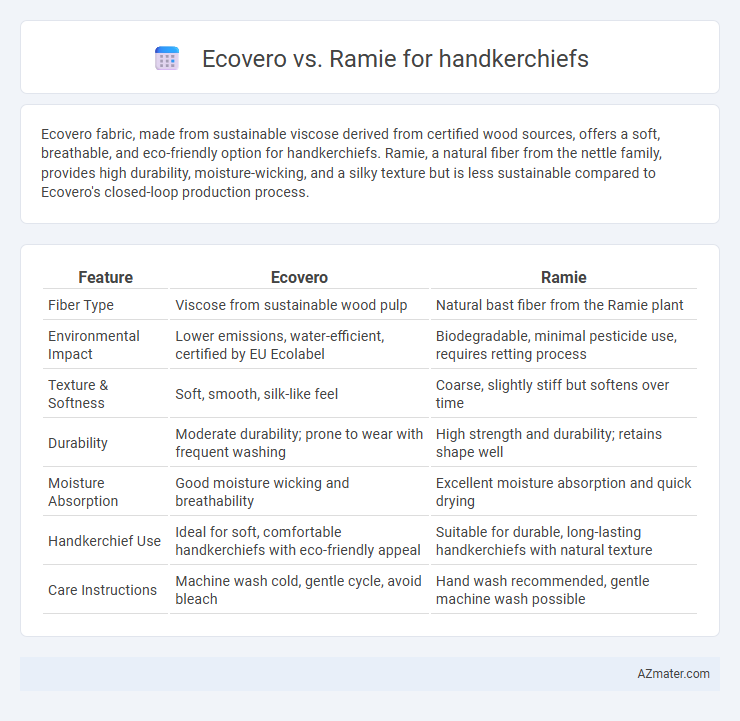Ecovero fabric, made from sustainable viscose derived from certified wood sources, offers a soft, breathable, and eco-friendly option for handkerchiefs. Ramie, a natural fiber from the nettle family, provides high durability, moisture-wicking, and a silky texture but is less sustainable compared to Ecovero's closed-loop production process.
Table of Comparison
| Feature | Ecovero | Ramie |
|---|---|---|
| Fiber Type | Viscose from sustainable wood pulp | Natural bast fiber from the Ramie plant |
| Environmental Impact | Lower emissions, water-efficient, certified by EU Ecolabel | Biodegradable, minimal pesticide use, requires retting process |
| Texture & Softness | Soft, smooth, silk-like feel | Coarse, slightly stiff but softens over time |
| Durability | Moderate durability; prone to wear with frequent washing | High strength and durability; retains shape well |
| Moisture Absorption | Good moisture wicking and breathability | Excellent moisture absorption and quick drying |
| Handkerchief Use | Ideal for soft, comfortable handkerchiefs with eco-friendly appeal | Suitable for durable, long-lasting handkerchiefs with natural texture |
| Care Instructions | Machine wash cold, gentle cycle, avoid bleach | Hand wash recommended, gentle machine wash possible |
Introduction to Ecovero and Ramie Fabrics
Ecovero is a sustainable viscose fiber derived from certified renewable wood sources, offering eco-friendly qualities like softness and breathability, ideal for handkerchief fabrics. Ramie, a natural bast fiber extracted from the stalks of the Ramie plant, is known for its strength, durability, and moisture-wicking properties, making it suitable for handkerchief production. Both fabrics present unique benefits, with Ecovero emphasizing environmental sustainability and Ramie providing natural resilience and longevity.
Origin and Production Processes
Ecovero is a sustainable viscose fiber derived from certified wood sources, primarily from responsibly managed forests in Europe, produced through an eco-friendly process that reduces water and emissions compared to conventional viscose. Ramie, a natural fiber obtained from the stalks of the Ramie plant native to Eastern Asia, is harvested and processed through traditional retting and degumming methods to extract the long, strong fibers. The production of Ecovero involves closed-loop technology that recycles chemicals, enhancing environmental sustainability, while Ramie's more labor-intensive processing retains its natural luster and durability ideal for handkerchief fabric.
Environmental Impact Comparison
Ecovero fibers, derived from certified sustainable wood sources, offer a significantly lower environmental footprint with reduced water usage and greenhouse gas emissions compared to conventional viscose used in handkerchiefs. Ramie, a natural bast fiber from the nettle family, requires minimal pesticides and fertilizers but involves energy-intensive processing that may offset some environmental benefits. When comparing handkerchief production, Ecovero's closed-loop manufacturing process ensures greater sustainability through resource efficiency, while Ramie's biodegradability enhances end-of-life environmental impact.
Softness and Comfort for Daily Use
Ecovero fibers offer superior softness and breathability compared to Ramie, making them ideal for handkerchiefs used daily against sensitive skin. Ramie, derived from natural plant fibers, provides durability and moisture-wicking properties but tends to be coarser, reducing comfort over extended wear. For optimal softness and comfort in daily handkerchief use, Ecovero blends outperform Ramie in texture and gentle feel.
Durability and Longevity
Ecovero fibers offer enhanced durability and a softer texture compared to ramie, making them ideal for handkerchiefs that require frequent washing and use. Ramie, known for its natural resistance to mildew and abrasion, provides strong longevity but may become stiff over time without proper care. Choosing Ecovero ensures sustained softness and resilience, while ramie excels in structural strength and moisture retention.
Absorbency and Practical Performance
Ecovero fibers offer superior absorbency compared to ramie, making them ideal for handkerchiefs that require quick moisture-wicking and soft texture. Ramie, while durable and lint-resistant, tends to be less absorbent and can feel stiffer against the skin during extended use. For practical performance, Ecovero combines sustainability with comfort, whereas ramie's strength suits heavier-duty applications but may compromise on handkerchief softness and quick drying.
Allergies and Skin Sensitivity
Ecovero fibers, derived from sustainably sourced wood pulp, offer a hypoallergenic quality ideal for sensitive skin, reducing the risk of allergic reactions commonly associated with synthetic fabrics. Ramie, a natural plant-based fiber known for its breathability and moisture-wicking properties, provides excellent comfort but may sometimes cause irritation in individuals with extreme skin sensitivity due to its rougher texture. For handkerchiefs, Ecovero's smooth, eco-friendly fabric supports allergy-prone users better, while Ramie's durability suits those seeking a more robust, natural option despite potential minor skin irritation.
Maintenance and Care Instructions
Ecovero handkerchiefs require gentle machine washing with mild detergent and cold water to maintain fabric quality and vibrant colors, avoiding bleach and tumble drying to prevent damage. Ramie handkerchiefs need hand washing or a delicate machine cycle with lukewarm water, using gentle soaps and air drying to preserve the fiber's strength and softness while minimizing shrinkage. Both fabrics benefit from ironing on low heat, but Ramie's natural plant-based fibers demand more careful handling to extend longevity compared to Ecovero's eco-friendly viscose blend.
Price and Availability
Ecovero fibers, derived from sustainable wood sources, typically come at a higher price point compared to Ramie, making them less common in budget-sensitive handkerchief production. Ramie is widely available due to its natural abundance and lower production costs, offering a cost-effective option for handkerchief manufacturers. While Ecovero handkerchiefs appeal to eco-conscious consumers willing to invest more, Ramie handkerchiefs remain popular for their affordability and accessibility in global markets.
Conclusion: Which Is Better for Handkerchiefs?
Ecovero offers superior sustainability with its eco-friendly viscose production, making it a better choice for environmentally conscious handkerchiefs, while ramie provides exceptional durability and natural antibacterial properties ideal for long-lasting use. The softness and smooth texture of Ecovero enhance comfort, whereas ramie's natural stiffness may affect the feel but improves wrinkle resistance. For handkerchiefs prioritizing eco-certification and comfort, Ecovero is preferable, whereas ramie suits users seeking toughness and natural fiber benefits.

Infographic: Ecovero vs Ramie for Handkerchief
 azmater.com
azmater.com